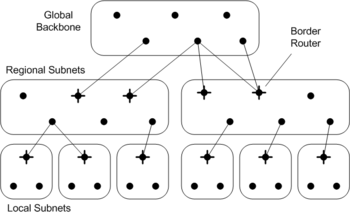User:David MacQuigg/Sandbox/Hierarchical routing: Difference between revisions
imported>David MacQuigg No edit summary |
imported>David MacQuigg No edit summary |
||
| Line 3: | Line 3: | ||
When networks grow beyond a few thousand routers, it becomes impractical for every router to compute a specific path to evey other router. The solution to this problem is to cluster the routers into indepependent routing areas or "subnets", and embed those subnets in a higher-level network. To the higher-level network, the subnet is just a single node. All traffic to any address in that subnet is routed through one or two "border" routers. | When networks grow beyond a few thousand routers, it becomes impractical for every router to compute a specific path to evey other router. The solution to this problem is to cluster the routers into indepependent routing areas or "subnets", and embed those subnets in a higher-level network. To the higher-level network, the subnet is just a single node. All traffic to any address in that subnet is routed through one or two "border" routers. | ||
Figure | Figure 1 shows a three-level hierarchy. Here, the second-level networks appear as subnets within the top-level network. With 1000 routers in each subnet, a network like this could have a billion routers. Changes in network topology propagate only within one subnet, and each subnet computes its own internal routing table, so the whole system can be as stable and efficient as one subnet. | ||
The real Internet is a bit more complex than this ideal hierarchy. There are many higher level networks serving the same set of subnets, and there are many links directly between subnets, avoiding the cost of routing up and down the hierarchy. Routing at the higher levels is more complex than just computing the shortest path. Network owners may want to provide special routing for preferred customers, or block other customers entirely. | The real Internet is a bit more complex than this ideal hierarchy. There are many higher level networks serving the same set of subnets, and there are many links directly between subnets, avoiding the cost of routing up and down the hierarchy. Routing at the higher levels is more complex than just computing the shortest path. Network owners may want to provide special routing for preferred customers, or block other customers entirely. | ||
In spite of these complications, the simple hierarchy is a good starting point to understand the Internet. | In spite of these complications, the simple hierarchy is a good starting point to understand the Internet. | ||
Revision as of 20:11, 28 December 2009
When networks grow beyond a few thousand routers, it becomes impractical for every router to compute a specific path to evey other router. The solution to this problem is to cluster the routers into indepependent routing areas or "subnets", and embed those subnets in a higher-level network. To the higher-level network, the subnet is just a single node. All traffic to any address in that subnet is routed through one or two "border" routers.
Figure 1 shows a three-level hierarchy. Here, the second-level networks appear as subnets within the top-level network. With 1000 routers in each subnet, a network like this could have a billion routers. Changes in network topology propagate only within one subnet, and each subnet computes its own internal routing table, so the whole system can be as stable and efficient as one subnet.
The real Internet is a bit more complex than this ideal hierarchy. There are many higher level networks serving the same set of subnets, and there are many links directly between subnets, avoiding the cost of routing up and down the hierarchy. Routing at the higher levels is more complex than just computing the shortest path. Network owners may want to provide special routing for preferred customers, or block other customers entirely.
In spite of these complications, the simple hierarchy is a good starting point to understand the Internet.
